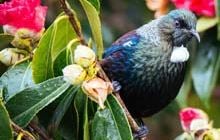Whitehead/pōpokotea
Introduction
The whitehead/pōpokotea has a series of clear tuneful calls that fill the forest with a pleasant cacophony of sound when they appear in flocks high in the canopy of the forest.New Zealand status: Endemic
Conservation status: Not Threatened
Found in: North Island of New Zealand
Species information: Whitehead/pōpokotea on NZ Birds Online
Facts
Whitehead/pōpokotea (Mohoua albicilla) are widespread and locally common in North Island beech forests, podocarp forest and old growth exotic plantation forests. However their range has shrunk since European settlement and they have disappeared from places such as Northland.
The birds are around 15cm long and have black beaks and eyes. Males have white heads and underparts, and pale brown upperparts, wings and tail. Females and juveniles are similar, but have brown on their nape and tops of their head.
In summer, chattering flocks of these ‘bush canaries’ can be heard as the juvenile birds do their teenage thing.
Sound recordings
Whitehead/pōpokotea flock (MP3, 707K)
00:44 – Flock feeding in a homestead garden and trees on Little Barrier Island.
Whitehead/pōpokotea territorial call (MP3, 3,549K)
03:46 – Adult male feeding under a canopy of beech trees in Whiteman's Valley, attracted by playback of calls, replying vigorously.
Our bird songs can be reused, even commercially, according to our copyright terms.
Threats
Unlike their South Island cousins the yellowhead or mohua, the whitehead is not a hole-nester which has probably helped it better survive the onslaught of introduced pests.
Forest clearance, once a threat, is luckily now a thing of the past.
You can help
Emergency hotline
Call 0800 DOC HOT (0800 362 468) immediately if you see anyone catching, harming or killing native wildlife.
On your property
- Trap predators on your property.
- Be a responsible cat owner.
In your community
- Find and volunteer with your local community group
- Trap predators in your community
- Get kids or schools involved
See Predator Free 2050 Trust - get involved for information.
Visiting parks, beaches, rivers, and lakes
- Leave nesting birds alone.
- Use available access ways to get to the beach.
- Avoid leaving old fishing lines in the water.
- Follow the water care code and local navigation bylaws.
- Do not drive on riverbeds, or keep to formed tracks if you have to.
- Check for pests if visiting pest-free islands.
With your dog
- Only take dogs to areas that allow them, and keep them under control.
- If you come across wildlife put your dog on a lead and lead it away.
- Warn other dog owners at the location.
- Notify DOC if you see wildlife being harassed by people or dogs.
- Get your dog trained in avian awareness.
- Learn about the Lead the Way programme which encourages dog owners to become wildlife wise and know how to act to protect coastal wildlife.
Specific ways to keep wildlife safe while with your dog on beaches.

